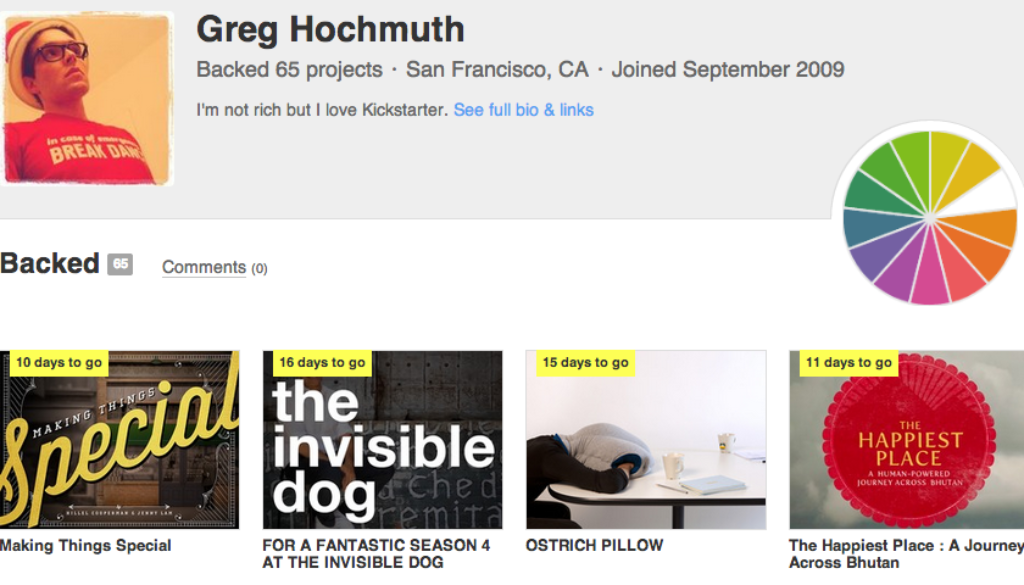Designing Sustained Engagement: 3 Questions to get you started
Today, while checking out a friend’s Kickstarter project, I noticed the pie-shaped investment categories widget on the profile page. It’s a simple, compact progress mechanic that shows which categories you’ve invested in. This widget provides a quick visual overview of investing activity (rollover each pie segment to see the category) – and a subtle suggestion to “fill out” the pie by broadening your interests.
On Kickstarter, what you invest in is a good proxy for your passions, aspirations and hobbies. It’s easy to see someone’s investment history on their profile; you can also browse (and potentially support) the projects they’ve backed. If you follow your friends on Kickstarter, you’ll get notices when they back new projects. The ongoing flow of projects and friends’ activity provides entertainment, inspiration and a sense of being part of something bigger. I’ve cancelled notifications on most websites I use – but I look forward to getting Kickstarter emails, because the content is almost always interesting to me personally.
What makes a digital experience engaging over time? How do you grab people’s attention during onboarding – and keep them interested and coming back for months, even years? The answer is… there is no one right answer, no magic universal formula. People are motivated by a variety of different experiences. Just look at today’s gaming landscape – from adrenaline-pumping shooters to slow-paced puzzlers to the sandbox-style creative freedom of Minecraft, one person’s beloved game is another’s worst nightmare.
To drive sustained engagement, you need to think about who you’re designing for, what motivates them, and how their experience will unfold over time. As you’re formulating your product vision and engagement strategy, here are some good starter questions to ask.
1) Who are your players? What’s their Social Engagement Style?
Knowing who you’re designing for is crucial, especially if you’re integrating game design into your service. Ever heard of Customer Development? This concept – popularized by the Lean Startup movement – is about understanding and testing out WHO is going to use your service. There are a wealth of resources available to help you create smart, testable hypotheses about who your early-adopter players are.
Once you’ve identified your core target audience, you can use our Social Engagement Styles matrix as an analytic framework to think through player motivations. Are you players motivated by Competition? Collaboration? Visible Achievement? Exploration? Self-Expression? What’s most important? What’s missing from their lives? How does their behavior shift at different times in their lifecycle? What qualities reinforce their identity, and tap into their aspirational view of themselves?
Kickstarter plays to our aspirational desire to be patrons of the arts and support projects that we believe in. With an ever-growing variety of projects, it’s a gold mine for Explorers – and the multi-tiered investment structure lets you Collaborate with a few clicks and a low $$ committment. You can see which friends backed a project – but not how much they contributed, which minimizes competition.
2) How will you define, measure, visualize and reward Progress Over Time?
People are deeply engaged by learning new things, attaining skills, and making progress along a meaningful continuum. What can YOUR players get better at? What skills are they developing when they engage with your service over time? What metric are they improving – and what makes that metric meaningful? What new powers, access and privileges open up as they progress?
Figuring out the right progress metrics for your system can be tricky. Sometimes, it’s straightforward – e.g. for students, progress metrics are structured around grades, courses, degrees, and certifications that open doors to the next level of schooling – and new job opportunities. For shoppers, it’s more varied – some care about saving $$ and finding rock-bottom prices; others are avidly building a collection of limited-edition designer clothes; still others are showing off their fashion choices to online buddies.
Your progress metrics should leverage the core value of your service – AND tap into the motivations and aspirations of your target players. Kickstarter’s simple progress metrics are a good start – but they have the data to know how often you’ve funded winning projects, and how early you were in those decisions. There’s a real skill buried in that data – it’s up to Kickstarter to decide what they want to do with it.
3) What Happy Habits drive sustained engagement during onboarding, habit-building and mastery?
Happy Habits are engagement loops that stimulate ongoing positive emotions. What’s the emotional arc for first-time players? What’s the trigger (internal or external) that reminds them to return? What kind of feedback and sense of progress do you provide? What’s the emotional payoff? Think about the emotional arcs and loops that your players experience during onboarding, habit-building and mastery. If you can design a compelling feedback loop that helps your players gain skill and move towards mastery of something they care about, you’re off to a good start.

February 20, 2014 @ 10:48 am
Designing Sustained Engagement: 3 Questions to get you started